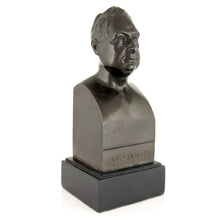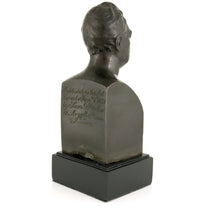Small Bronze Bust of ‘The Sailor King’ William IV, 1831
- Regular price
- £385
- Sale price
- £385
- Regular price
-
- Unit price
- /per
Adding product to your cart
Height of bust: 14cm (5.5in)
Bronze. Herm form, Inscribed to the reverse ‘Publish’d as the Act / Directs Jan ‘1’ 1831 / by Saml. Parker / 12 Argyll Place / London’. Overall height: 17cm (6.7in).
Parker was a London craftsman working principally in bronze. He was almost certainly the grandson of William Parker, a glass manufacturer, and the son of Samuel Parker, who took over the family business at 69 Fleet Street in 1798. William Parker and his successors were George IV’s chief lighting suppliers, providing him with chandeliers, patent lamps, candlearms and lanterns. These were usually of cut glass and incorporated gilt-bronze fittings. The younger Samuel Parker worked with his father and brother for a time but by 1820 he had moved to 35 Argyll Street and set up on his own account as a bronze manufacturer. From 1824 onwards he had a workshop at 12 Argyll Place, in addition to the Argyll Street house.
Read more
In 1821-2 Parker made a marble chimneypiece with ormolu mounts to designs of Robert Jones, for the Royal Pavilion at Brighton. This sumptuous work features two large Chinese figures in niches, cast in metal by Parker and painted in imitation of enamel by Jones. Parker supplied the accompanying fender and fire irons, as well as decorative ormolu mounts for a clock plinth (the marble was provided by Henry Westmacott), a pair of candelabra, a pot-pourri tripod incorporating pieces of oriental porcelain and two cabinets, all designed by Jones for the same room. Not all his work there was of the expected standard. Deficiencies in the metal door handles he had supplied were later made good by James de Ville.
Parker’s work clearly found favour with both George IV and his architect John Nash, for he was employed in the remodelling of Buckingham Palace during the 1820s and 1830s. Yet, in spite of his apparent success Parker found himself in financial difficulties and he was declared bankrupt in 1832. At that time he was still executing work for Buckingham Palace and a considerable number of ornaments for the drawing room chimneypieces had yet to be cast. Parker refused to give up the models and these chimneypieces and overmantels appear to have been abandoned. He continued in business after the settlement of his debts in 1834, but possibly only as a lamp maker. In 1839 he was described in the London Directory as a ‘Lamp and coffee pot manufacturer’ and by the following year he had moved to the Egyptian Hall, Piccadilly, where he called himself a ‘Lamp and patent steam fountain coffee pot manufacturer’. He is last recorded in 1843 at the Egyptian Hall - today the site of Piccadilly Arcade and our shop!






